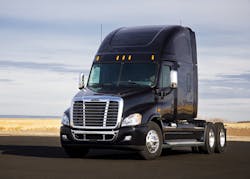Federal fuel economy rules pose complex challenges
TAMPA, FL. Despite holding out the promise of fuel savings on the order of $50 billion, the approaching implementation of the federal government’s greenhouse gas (GHG) emissions/fuel economy rules for heavy and medium-duty trucks continues to pose a series of complex, and potentially costly, challenges for both OEMs and fleets alike.
During a special technical session held here at the 2012 Technology & Maintenance Council’s annual meeting, Byron Bunker, acting director for the compliance division of the Environmental Protection Agency’s (EPA) office of transportation and air quality, said those rules “are far more complex” than similar new fuel economy standards introduced for light-duty vehicles last year, “as heavy and medium duty vehicles are far more varied than light duty vehicles.”
Bunker added that there’s a certain time pressure as well, as the new GHG/fuel economy rules “start very soon, beginning with model year 2014 vehicles, which is just 18 months away,” and as they will be imposed gradually between 2014 and 1017, that gives engine and vehicle makers just four years worth of lead time to comply with them.
Bunker stressed, however, that EPA believes the savings will be significant for the trucking industry once the rules – which run to some 400 pages in length – are fully in place. The agency calculates that the fuel efficiency mandates will help the trucking industry reduce fuel consumption on the order of 530 million barrels of oil which, with diesel priced at $3.50/gal., results in $50 billion in fuel savings.
Even with EPA’s estimate that it will cost the industry $8 billion to comply with the new standards, the industry should still net some $42 billion in savings overall from greater fuel efficiency, Bunker said.
He noted that the new GHG/fuel economy rules mandate separate yet parallel efficiency improvements for engines and vehicles. To date, EPA expects engine fuel efficiency to improve 3% in 2014 and a further 3% by 2017.
On the vehicle side, fuel economy gains are expected to be derived from five main areas, said Bunker. These are aerodynamic improvements, reductions in tire rolling resistance, vehicle weight reductions, speed limiting technology, and reductions in engine idling. He stressed, however, that fleets will not be compelled to make any specific changes to engine, transmission, or axle specs.
“We want fleets to maintain the ability to make spec’ing decisions based on their actual operations, not a national average standard,” he noted. “They need to be able to optimize their vehicles correctly.”
EPA also, at this time, isn’t seeking to include trailers as part of this fuel efficiency improvement effort. “Until we have an inexpensive way to consistently test trailer fuel efficiency, it will remain hard to gauge,” said Bunker. “So we are not planning on regulating trailers.”
However, even limited to just those five areas, OEMs in particular are concerned about the unspoken complexities that will be involved.
“Take aerodynamics for example: according to our calculations, there are 14,555,520 possible aerodynamic configurations than can be deployed to help meet the new rules,” explained Al Pearson, chief engineer-product validation engineeringfor Daimler Trucks North America (DTNA). “And these involve only significant changes for day cabs and sleepers.”
He also noted that, where tires are concerned, "we have over 50 tire variants front and rear.”
Pearson further noted that the aerodynamic category alone is made up of five distinct “bins,” while Class 7 and 8 trucks will be broken down into nine separate categories for GHG/fuel efficiency designation.
On top of that, the new rules task OEMs with determining the classification for each vehicle they build, be it a long-haul tractor-trailer, medium-duty truck, or vocational vehicle. While vocational trucks will have the most leeway in complying with the new rules, OEMs will restricted to building 21,000 such units in a three-year period.
OEMs will also be tasked to calculate and certify the GHG emissions levels for each class of vehicle they build using a special greenhouse gas emissions model (GEM) tool developed by EPA to ensure manufacturers are building trucks on a yearly basis that emit no more than the GHG grams per ton-mile levels set for each vehicle classification.
“Specs will need to be extracted exactly as ordered and plugged into the GEM tool, so we’re going to need an automated documentation system to do it,” said DTNA’s Pearson. “It shows how complex calculating all of this is going to be.”
About the Author
Sean Kilcarr
Editor in Chief
Sean Kilcarr is a former longtime FleetOwner senior editor who wrote for the publication from 2000 to 2018. He served as editor-in-chief from 2017 to 2018.
